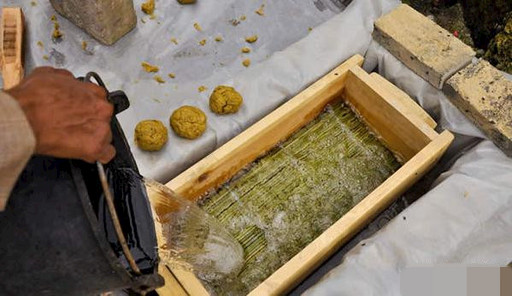
. > FOCUS > SCIENCE & HUMANITY
Rehabilitation research deepens understanding of ancient technologies
Author : Wang Guanglu Source : Chinese Social Sciences Today 2016-12-12

The fixed-mold papermaking method produces thick and rough paper, which is believed to be the earliest papermaking method in China.
From Nov. 25 to 27, the 14th International Conference on the History of Chinese Science and the first International Symposium on the Four Major Inventions of Ancient China was held at the Nanjing University of Information Science and Technology, with the theme “The Ancient Chinese Science and Civilization Process.” More than 160 scholars attended the meeting and discussed related issues on the four ancient Chinese inventions and the development of ancient science and technology.
Take papermaking, for example. According to the History of the Later Period of the Han Dynasty, this technology was invented by Cai Lun in the Eastern Han dynasty (25-220), but there is also evidence to suggest that papermaking and paper may have existed before that time. Li Xiaocen, a professor from the Institute of History of Science and Technology at Nanjing University of Information Technology, said that in 1986, a piece of “paper” was found in the Western Han Dynasty (206 BC-AD 25) Fangmatan tombs in Tianshui, Gansu Province. Some scholars think it is the earliest paper, insofar as it was made in line with the papermaking process, but there are also opposing views.
Or, take compasses as a point of investigation. In the past 90 years, since Zhang Binghe published his article “On the Compass” in 1942 and Zhang Yinlin released Ancient Chinese Technologies and Their Creators, a number of scholars, such as Wang Zhenduo, Liu Bingzheng and Dai Nianzu, have researched and debated core questions about the ancient compass recorded in historical archives and the practicality of a spoonshaped compass before the emergence of the needle-like magnetic compass widely used today.
In recent years, the academic community has attached increasing importance to the inventions of ancient Chinese science and technology. While they concentrated on related issues, scholars were bewildered by some questions such as whether the ancient compass, or sinan, can be regarded as one of the four inventions of ancient China, said Guan Zengjian, a professor from the Institute of Science History and Culture at Shanghai Jiaotong University. Like the sinan, many sciences, technologies and equipment of ancient China only have literary records and descriptions, lacking physical description, which is a common difficulty when researching the history of these technologies.
Scholars believe that current controversies and questions can be resolved in a number of ways. Analysis of archaeological excavations and information pertaining to cultural relics helps to find evidence. At the same time, deepening research on the history of science and technology through restoration is also necessary.
Sun Xiaochun, director of the Chinese society for the History of Science and Technology and professor from the University of Chinese Academy of Sciences, is one of those who have taken charge of the rehabilitation research project on the Astronomical Clock Tower invented by Su Song in the Song Dynasty (960-1279). Sun said rehabilitation research could enhance understanding of the experiences of these ancient cultures and the problems they encountered. It helps to explore the principles and ideas embedded in these ancient Chinese sciences and technologies while deepening understanding of modern science and technology.
Through more than 20 years continuous study on “ancient paper,” Li found that traditional Chinese created paper primarily through two distinct technologies: fixed-mold and movable-mold papermaking. Cai Lun’s papermaking method belonged to the former type while the latter kind of papermaking method originated earlier. Paper made by the two methods each look different. Paper made through a fixed-mold is thick and rough, with unevenly distributed fibers and often left with no texture of the mold on the surface; while the movable-mold method produces thinner paper, with smoother surfaces, evenly distributed fibers and texture on the surface.
As a branch of history, the history of science in general has a similar research methodology with other historical research except the particularity of its research objects and corresponding special requirements regarding the researcher’s knowledge background, said Liu Bing, a professor from Tsinghua University. He added that the textual research is a unique and worthy inheritance of research methods in traditional Chinese learning, but overuse of textual criticism and historical data and replacing them with overall historical research, is an undesirable research paradigm. In the past studies of the history of science in China, too much emphasis on the tradition of textual research has restricted the development of disciplines.
Ye Shengtao made Chinese fairy tales from a wilderness
Ye Shengtao (1894–1988) created the first collection of fairy tales in the history of Chinese children’s literature...
-
How northern ethnicities integrated into Chinese nation
2023-09-18
-
Mogao caves
2023-09-12
-
Mogao Grottoes as ‘a place of pilgrimage’
2023-09-12
-
Time-honored architectural traditions in China
2023-08-29
-
Disentangling the civilizational evolution of China
2023-08-28
-
AI ethics in science fiction
2023-08-23













 2011-2013 by www.cssn.cn. All Rights Reserved
2011-2013 by www.cssn.cn. All Rights Reserved